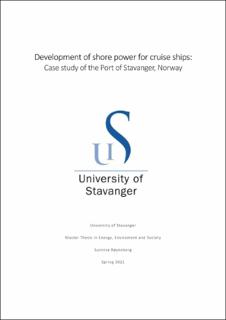| dc.description.abstract | The growing cruise industry has impacted harbouring cities through noise and air pollution causing distress and harm to citizens. Shore power technology is a promising solution for these issues and is being implemented in the cruise industry. This paper explores the different perspectives of the development with attention to challenges and the use of regulations. The research is a case study of the Port of Stavanger where shore power is being implemented and local authorities are attempting to control the industry’s impact on the city. Through document analysis of strategies, regulations and incentives as well as interviews with actors involved in the development, this research highlights the complexity of the cruise industry. Theoretical perspectives on energy transitions, governance and stakeholder management provides a deeper understanding of the challenges of regulating the industry and how the shore power development can be seen as a part of a larger transition in the cruise industry. The paper discusses aspects of local regulation with attention to stakeholder management and governance theory to review the impact of local decision making. Aspects of the cruise lines approach to shore power is discussed in light of transition and regime resistance literature to explore the challenges and implications of regulating the industry. National regulation is explored as an option of increasing the speed of shore power development, where attention to the intricate operations and complex setting of cruise industry makes this task difficult. The paper aims to contribute to the maritime governance field when discussing the implications and challenges of regulating the cruise industry. A shore power development for the industry is feasible and called for, to which this paper questions the need of regulatory tools as an mechanism to ensure a stable and accelerated development along the Norwegian coast as a contribution to the global ambition of a sustainable development of the cruise industry. | |
